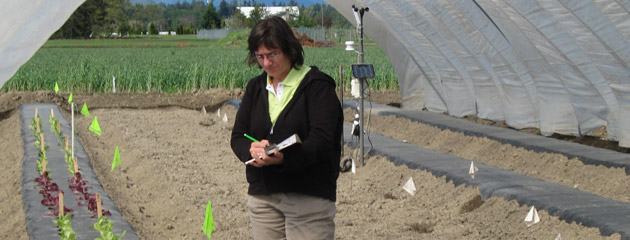

Aug 5, 2010Multi-state tunnel study looking at mulches and more
By Derrek Sigler, Assistant Editor
At the Washington State University (WSU) Northwest Research Center in Mount Vernon, they started a small-scale project to look at growing strawberries, tomatoes and lettuce under a high tunnel. When they started looking into expanding the study, they found several other institutions looking at the same things, as well as a team looking at biodegradable mulches.
What came from these beginnings is a multi-state study. Along with WSU, there is Western Washington State University, Texas A&M, Texas Tech and the University of Tennessee at Knoxville (UTK). This group of institutions includes 18 research scientists, a collection of graduate students and an advisory committee made up of growers, mulch and tunnel manufacturers and regional Extension agents.
Karen Leonas, chair of WSU’s department of apparel, merchandising, design and textiles, said, “This is a truly unique combination of resources and people coming together to address a real-world issue and come up with environmentally sound solutions.”
Each location is running four tunnels with equal amounts of lettuce, strawberries and tomatoes planted in replications and an equal plot grown outside the tunnel for comparison. Each location has slightly different tunnel construction variations and research protocols.
“We have vast differences in climates between Washington, Texas and Tennessee, so each area has had to adapt the protocols from the study slightly to work for each environment,” said Debra Inglis, a plant pathologist with WSU. “For instance, Texas has such higher winds that they had to modify their tunnel structure for it, whereas we have made our tunnels more mobile so they can be taken down in winter as they are not rated for snow load.”
“Putting up a tunnel in west Texas means you’re going to need a very high-quality tunnel,” said Russ Wallace, associate professor and Extension vegetable specialist with Texas AgriLife Research and Extension. “You’ll need closer spacing, around 4 feet between rafters, for extra support – and planting hedgerows for added windbreaks is a good idea too.”
Wallace said it was important to get the strongest plastic available.
“We chose a 5.2-ounce, heavy-duty plastic that has an interwoven fiber for something called Ripstop technology,” he said. “So far, it has resisted damage from the hail, although we have yet to be hit by any serious weather.”
UTK is using two types of tunnels, with four in the study. The newer tunnels have roll-down sides, as opposed to roll-up.
“This has been a tremendous bonus in pest control and in heat and frost control,” said Annette Wszelaki, a vegetable Extension specialist with UTK. “The sides keep rabbits and such out.”
Mulches are a vital part of the study, said Inglis.
“You have to have mulches under a high tunnel,” she said.
The study is looking at biodegradable mulch inside and outside of the tunnels. Why biodegradable mulches? They leave no toxic residues in the ground and growers save money on removal, recycling and landfill costs, according to Dubois Agrinovation, makers of BioTELO, one of the mulches in the study.
“Traditional mulches break down too fast, allowing the weeds into the crop,” said Wszelaki. “Newer versions are indistinguishable from black plastic. Several test mulches are corn starch-based and we’re also trying paper mulches and several different fabrics.”
The materials unit at UTK is looking at how the mulch breaks down in the field. They are working on answering a series of questions, Inglis said. How is it affecting the microbes in the soil? What does the grower have to do to initialize the breakdown? Is heat needed? How does plowing affect the mulch? Will water break down the mulch sufficiently?
With the different biodegradable mulches come other issues, according to Inglis. Growers indicated that there are shared characteristics that make for acceptable mulches. They have to have a uniform thickness that will adequately hold up to degradation. They have to have the right amount of rigidity. The tensile strength has to fall within an acceptable level to guard against breakage. Inglis said they would test all of these characteristics at four points throughout the growing season.
“You can plant earlier, up to a month or more, inside the tunnel than you can outside,” Inglis said. “We’re looking to help growers get the market premium for their crops by having a quality product earlier than previously available.”














